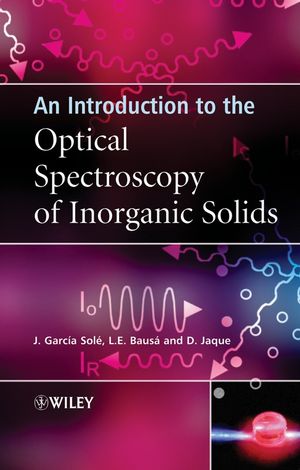An Introduction to the Optical Spectroscopy of Inorganic SolidsISBN: 978-0-470-86886-7
Paperback
304 pages
April 2005
 This is a Print-on-Demand title. It will be printed specifically to fill your order. Please allow an additional 10-15 days delivery time. The book is not returnable.
|
||||||
ACKNOWLEDGEMENTS.
SOME PHYSICAL CONSTANTS OF INTEREST IN SPECTROSCOPY.
I FUNDAMENTALS.
I.1 Origin of the Spectroscopy.
I.2 Electromagnetic Spectrum. Optical Spectroscopy.
I.3 Absorption. The Spectrophotometer.
I.4 Luminescence. The Spectrofluorimeter. Time resolved luminescence.
I.5 Scattering. The Raman effect.
I.6 Advanced topic: The Fourier Transform Spectrophotometer.
Exercises.
II LIGHT SOURCES.
II.1 Introduction.
II.2 Lamps.
II.3 The Laser. Basic principles.
II.4 Types of Lasers.
II.5 Tunability of laser radiation. The Optical Parametric Oscillator.
II.6 Advanced Topic:1) Site Selective Spectroscopy. 2) Excited State Absorption.
Exercises.
III MONOCHROMATORS AND DETECTORS.
III.1 Introduction.
III.2 Monochromators.
III.3 Types of detectors. Basic parameters.
III.4 The Photomultiplier.
III.5 Signal/noise ratio optimisation.
III.6 Detection of pulses.
III.7 Advanced Topic: Detection of very fast pulses; The Streak Camera; The Correlator.
Exercises.
IV. OPTICAL TRANSPARENCY OF SOLIDS.
IV.1 Introduction.
IV.2 Optical magnitudes and the dielectric constant.
IV.3The Lorentz oscillator.
IV.4 Metals.
IV.5 Semiconductors and insulators.
IV.6 Spectral shape of the fundamental absorption edge.
IV.7 Excitons.
IV.8 Advanced topic: The colour of metals.
Exercises.
V. OPTICALLY ACTIVE CENTRES.
V.1 Introduction.
V.2 Static interaction. The crystalline field.
V.3 Band intensities. The oscillator strength.
V.4 Dynamic interaction. The coordinate configuration diagram.
V.5 Band shape. The Huang-Rhys factor.
V.6 Non radiative transitions. Energy transfer.
V.7 Advanced topic: Determination of quantum efficiencies.
Exercises.
VI. APPLICATIONS: RARE EARTH AND TRANSITION METAL IONS, COLOUR CENTERS.
VI.1 Introduction.
VI.2 Trivalent rare earth ions. Diagram of Dieke.
VI.3 Non radiative transitions in rare earth ions; The "energy gap" law.
VI.4 Transition metal ions. Tanabe- Sugano diagrams.
VI.5 Colour centres.
VI.6 Advanced topic: 1) The Judd and Ofelt method. 2) Optical cooling of solids.
Exercises.
VII. GROUP THEORY AND SPECTROSCOPY.
VII.1 Introduction.
VII.2 Symmetry operations and classes.
VII.3 Representations. The character table.
VII.4 Reduction in symmetry and splitting of energy levels.
VII.5 Selection rules for optical transitions.
VII.6 Illustrative examples.
VII.7 Advanced topic: Applications to optical transitions of Kramers ions.
Exercises.
APPENDICES.
APPENDIX A1.- The joint density of states.
APPENDIX A2.- Effect of an octahedral field on a valence electron d1.
APPENDIX A3.- Calculation of the spontaneous emission probability by the Einstein thermodynamic treatment.
APPENDIX A4.- Determination of the Smakula´s formula.
INDEX.



